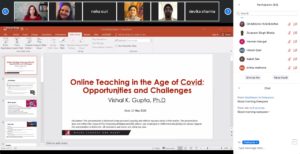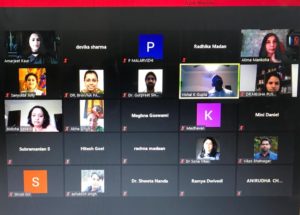IILM University organized an online FDP on ‘Online Teaching in the Age of Covid19: Opportunities and Challenges’ by Prof. Vishal K. Gupta, University of Alabama, USA on 22nd May 2020.
Brief Profile of the speaker:
Prof.Vishal Gupta presently associated with University of Alabama, USA is an experienced professor with a passion for research and teaching. He has published over 50 peer-reviewed journal articles, including in the prestigious journal viz., Academy of Management Review, Journal of Applied Psychology, and Journal of Management, among others. He teaches courses in strategic management and entrepreneurship at various levels from undergraduate to PhD. His global teaching experience includes United States, India, and Bahrain. He is also a professional speaker for students (career guidance and job-market readiness), business executives, and small business owners.
A lot of interesting insights were shared by Prof.Vishal with the participants. He shared with the participants how COVID-19 is posing challenges to all the industries and higher education is not untouched, however while most of the industries are getting attention its impact on the higher education is not being talked about. He expressed serious concerns on how some technical and engineering courses will be delivered completely online. He further expressed that University administrators world over were not prepared for the situation and even the most progressive and well known Universities/Institutes took a while to respond in such pandemic times. According to Prof.Vishal most of the American Universities tried to keep their students engaged by making reading material and pre-recorded videos on either blackboard or other Learning Management Systems. The idea was to buy time to move online eventually.
Challenges of going online:
The most interesting part of the FDP was when Prof Vishal elaborated on the various challenges faced by the two important stakeholders of Higher Education: Professors & Students after moving to online teaching. As all participants were academicians they could relate to every aspect of the discussion. Certainly, the challenges identified by Prof Vishal can be generalized to the entire education Industry irrespective of culture and economic development. He felt students across the globe are same and they are yet to come to terms with the changing teaching platforms adopted in the new normal times.
He narrated instances where students who attended an online class with their video on were found not to be dressed properly. Hence students may have to be oriented on the etiquettes to appear for online classes.
He expressed his apprehension regarding the decision of few American Universities to open campus for physical classrooms citing issues of social distancing among students and the risk associated with Professors carrying virus back home.
Opportunities:
Nevertheless he also cited some opportunities that can be harnessed by teachers, students and Institutes alike in this present scenario. Going forward, Universities may have to reduce the cost of their courses as they are offered online, which may be a benefit for students. Mandatory attendance norms for students may have to be relaxed as students may come out with all kinds of problems including internet accessibility.
Research cab be given high priority as Professors may get more time, however Prof Vishal mentioned that this cannot be generalized but is true for Professors of American Universities. He further added that in this situation Professors also have the task of making online evaluation more stringent as cheating during examinations cannot be controlled.
Q&A
One participant posed a question regarding student engagement online for which Prof Vishal advised that teachers should focus on textbook teaching and keep the class duration less. They should suffice their online sessions with good videos and latest news articles. Also he advised that teachers should weekly conduct doubt-clearing classes for students. Student engagement becomes key for successful conduct of online classes.
Overall the session was very engaging and interactive and Faculty members of IILM appreciated Prof Vishal Gupta’s view on the present scenario and need for blended learning.






